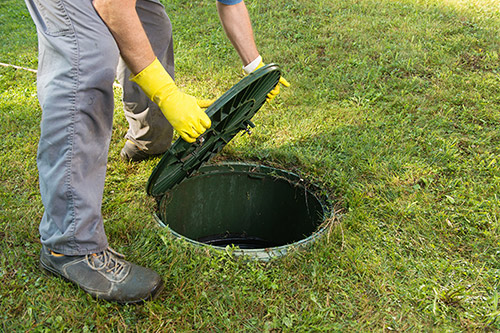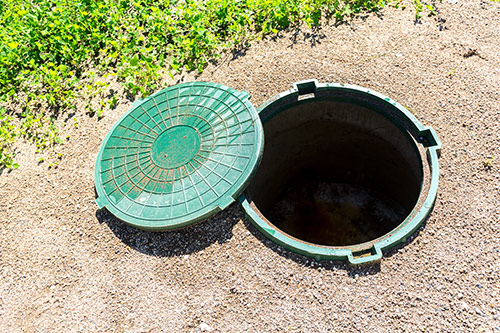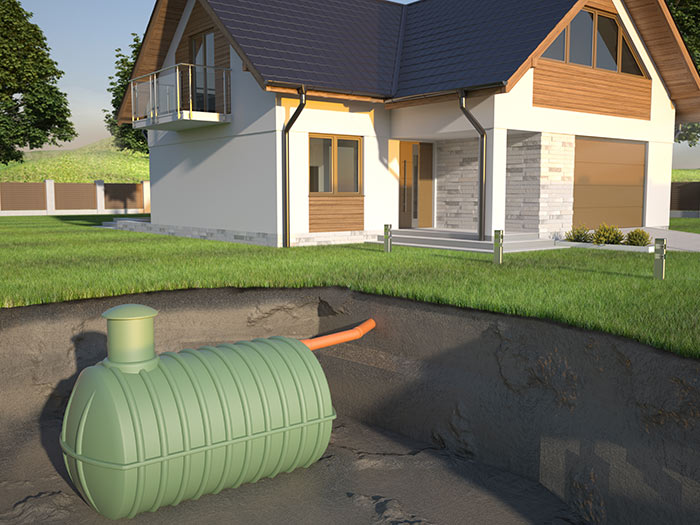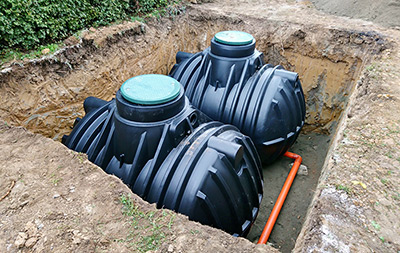
1. You’ll Never Have to Replace a Well-Maintained Septic Tank
In terms of septic tank longevity, some people may tell you it needs replacing at least every 20 years, while others will say that it could last a lifetime with proper maintenance. The truth is likely somewhere in the middle.
No matter how good your septic system maintenance is, the tank will need replacing at some point. Poor management could see the system fail a little after five years of use. However, with regular tank pump-outs, efficient water use, appropriate waste disposal, and careful drain maintenance, your septic system could still work after 20 to 30 years or more.
2. Using Additives Means Pump-Outs Are Unnecessary
Regular tank pump-outs (ideally every two or three years) are necessary for septic system maintenance. These typically occur when the solid waste in the tank reaches between 30% and 50% of its total storage capacity. Professionals will empty the tank and ensure it’s completely clear of the solid sludge that accumulates at the bottom of the tank and the lightweight scum that floats at the tank surface. Without pump-outs, you will end up with expensive repair bills, clogs, and a significant reduction in the system’s longevity.
You may have heard that septic tank additives can eliminate the need for this process. The claim is that these microbes and enzymes can be added to your septic tank to enable the complete breakdown and digestion of sewage waste. They can interfere with solids settling, corrode tank walls, and leach harmful chemicals into the drain field. Even the Environmental Protection Agency does not recommend their use.
If you don’t want wastewater suddenly backing up into your house, stick with periodic pump-outs and don’t try to do them yourself. Local authorities have strict regulations in place for how to handle and dispose of solid waste. Hire a septic tank cleaner near you to tackle this complex job.
3. A Full Tank Always Needs Pumping
Just because a septic tank looks full doesn't mean it’s time for a pump-out. Even after doing so, an average family-size tank will fill up to around 12 inches within a week.
You only need to do a pump-out when there are high solid levels in the tank (they should take up about a third of it). A professional septic tank cleaning company can establish this point by conducting a sludge test that checks the solid levels present.
4. Repairing a Tank Is Preferable to Pumping Out
If you have a tight few months money-wise, you might think it won’t matter if you put off getting a scheduled pump-out on your septic tank. After all, how expensive could the repairs be if something goes wrong?
The cost to pump a septic tank is usually only a few hundred dollars, but a backed-up system could cause unpleasant, unsanitary problems that are costlier to fix.
Once you smell odors from your drains or your toilet won’t flush anymore, this can indicate that damage has already occurred. Sometimes, it could result in you calling a local septic tank installation company to replace the tank.
5. You Can’t Repair a Clogged System
If your system gets clogged up, you may hear the only option is to replace the tank or the entire system. However, depending on where and why the clog has occurred, a pressure-washing technique called jetting can often clear the system so it continues to function normally.
Always be cautious if someone tells you that things cannot be fixed—they may be more interested in the low-hanging fruit than making the more difficult repairs.
This involves high-pressure water pumping through your septic pipelines to dislodge debris. However, you won’t be able to tackle major clogs or problems in the system pipelines with this technique, and it isn’t suitable if your pipes are made from more fragile clay rather than rigid PVC. Contact a local septic tank repair specialist for further advice. They use specialist equipment. If this technique isn’t done correctly, it can lead to pipeline damage and groundwater quality problems.
6. Seeding Your Tank Is Beneficial
Seeding refers to getting good bacterial growth started in a freshly pumped system to help break down the waste. To do this, some people suggest dumping a pound of yeast, some manure, or even dead pests down your toilet.
You’ll be glad to hear this is entirely unnecessary. As soon as you flush regular toilet waste away, it’s enough to introduce the beneficial bacteria needed to kick-start the system.
7. You Can Flush Most Things Down the Drain
While septic systems are relatively robust, it doesn’t mean you can chuck anything you like down the toilet or drain. They’re designed to handle only two things: wastewater and sewage.
Nothing beyond toilet paper and standard waste should enter a septic system. Even adding bleach and strong disinfectant cleaners can upset the balance of the beneficial microbes needed to break down sewage. Coffee grounds, feminine hygiene products, cat litter, grease, and oils are common problematic items flushed down drains or toilets. These items in the system can lead to drain blockages, irreparable tank malfunctions, pipe damage, and the release of toxins or dangerous bacteria into the environment.
8. It’s Fine to Build on Top of Your Septic Tank
Some people believe building a structure on top of the septic tank isn’t a problem. After all, they’re so far underground that it shouldn’t matter, right?
Adding a deck, patio, or garden shed on top can make it difficult or impossible for the pros to access the septic tank when it needs pumping, repairing, or replacing.
It can also cause problems with the breakdown of wastewater entering the drainage field. The soil won’t have full oxygenation, and this can lead to backups in the system.
Instead, growing a lawn or planting non-aggressive, water-loving plants over your septic system is a perfect solution.
9. Professional Maintenance Isn’t Necessary for a Septic System
Regular professional maintenance is essential to maximize the longevity of your septic system. A septic system specialist can test the waste levels in a tank to check when it needs pumping, perform those pump-outs, and reduce the chances of problems with poor drainage and clogs.
Getting into the habit of arranging an inspection by a reputable local contractor every year or two is well worth the expense.
For more information on septic system installation, contact Morse Engineering and Construction.
Source: angi.com



